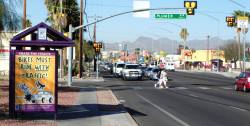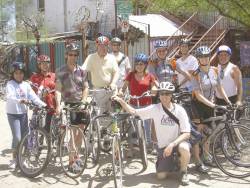Bicycle and Pedestrian Safety and Education Program
Tucson and Eastern Pima County, Arizona
Source: Pedestrian and Bicycle Information Center (PBIC)
Problem
This project was developed to improve safety for pedestrians and bicyclists, the most vulnerable users of our transportation system. According to the National Highway Traffic Safety Administration (NHTSA), pedestrians in Arizona have the second highest traffic fatality rate based on population in the U.S.; bicyclists have the highest fatality rate. The Federal Highway Administration (FHWA) indicates that Arizona is 47th in the nation in terms of the amount of federal funding spent on addressing causes of traffic fatalities on Arizona roadways. Moreover, less than 0.5 percent of federal funds that Arizona receives are spent on safety projects and programs for pedestrians and bicyclists, yet pedestrian and bicycle fatalities average nearly 13 percent of total traffic fatalities. The FHWA estimates that less than $1.00 per year per student is currently spent teaching children safe traffic skills, and virtually no federal funds are spent on adult pedestrian and bicycle safety classes.
Background
In 2004 Pima County developed a proposal in partnership with the City of Tucson for federal transportation enhancement funds to improve safety for pedestrians and cyclists using public outreach techniques, safety training, and minor infrastructure improvements. The proposal was funded through the Arizona Department of Transportation and includes substantial local matching funds. The program officially got underway in 2005 and complements another safety outreach effort funded through local funds and transportation enhancements, the Pima County-Tucson Safe Routes to School Program.

Bus shelter safety signs and HAWK pedestrian crossing lights are only two of the many bicycle/pedestrian safety improvements included in the Pima County-Tucson Program.
Photo: Matt Zoll
Solution
The goals of the Pima County-Tucson Bicycle and Pedestrian Safety and Education Program are to reduce roadway crashes and injuries among pedestrians and bicyclists, increase awareness of the responsibilities of pedestrians, bicyclists and motorists, and promote tolerance among all roadway users.
This program includes television and radio public service announcements (PSAs) promoting pedestrian and bicyclist safety, educational videos for police training and for student safety classes, traffic safety guides and maps, posters, helmets, front and rear bicycle light kits, and free cycling safety classes for the public. The program also entails close coordination with police and safety educators. Safety messages address motorist failure to yield to bicyclists and pedestrians, wrong-way bicycle riding, helmet use, use of bike lights at night, running stop signs and red lights by motorists and bicyclists, speeding, and other issues. The intent is to promote an overall "share the road" ethic within the community.
Partners in the education effort include area police departments, youth driver training schools, Arizona Motor Vehicle Division offices, the City of Tucson Safe Kids Program, AAA, the Governor's Office of Highway Safety, the National Traffic Safety Institute, bicycle clubs, area bike shops and libraries, and other groups and agencies. A demonstration project for bike lane stencils and signage that addresses wrong-way bicycle riding is incorporated into the project.
Result
Public outreach
Approximately 180 4-by-6-foot signs with messages promoting bicycle and pedestrian safety have been installed at bus shelters and 40 Share the Streets bus bench signs have been posted at bus stops around the region. Safety signs and posters have been put up in over 40 regional libraries and bike shops. The program has also distributed 50,000 regional bike maps with safety information and 40,000 Share the Road motorist/bicyclist pocket guides, including Spanish-language guides. The program also publishes a monthly safety newsletter.
Public service announcements promoting safety for bicyclists and pedestrians are periodically run on local radio stations and on TV. Additional PSAs are run with a major emphasis on school safety. The program is developing a police training video on bicycle and pedestrian legal issues and safety, to be implemented within area police departments in fall 2008.

A celebrity endorsement: Tucson Mayor Bob Walkup (fourth from left) takes the Pima County-Tucson bicycle safety class.
Photo: Ignacio Rivera.
Safety training
A Bicycle Ambassadors program has teens and adults assisting with the Safe Routes to Schools program, bicyclist safety outreach events, bike safety classes, and other activities including safety outreach to students at the University of Arizona. The program has trained over 1,500 adults and children in the past two years in nine-hour bicycle safety training classes. (The classes are divided into two parts: a three-hour classroom segment and a 6-hour riding segment that includes safety drills.) Three separate train-the-trainers courses have been held for bicycle safety instructors, and the region now has the largest number of League of American Bicyclists League Certified Instructors in the nation.
The program is developing a bicycle driver diversion class to offer safety classes to bicyclists who receive citations for traffic infractions. The classes will be implemented working with the Bike Ambassadors and League of American Bicyclists safety instructors in fall 2008.
Infrastructure improvements
Over 400 bike stencils have been installed in bike lanes; in the future "Wrong Way" bicycle signs will be installed on select roadways where wrong-way riding is a concern. The program has also coordinated with traffic engineering staff on the prioritization and location of HAWK (high intensity activated crosswalk) pedestrian crossing signals Over 70 of these signals have been installed in the Tucson-Pima County region.
Evaluation
Evaluation is currently underway to determine the effects of the safety outreach efforts and identify additional safety countermeasures and sources of funding to continue and expand the program. The Pima County Department of Transportation (DOT) is collecting data on the number of crashes, type and severity, to compare with an analysis done in 2005. A report will be available in late 2008.
Cost
The program is funded through a $454,000 federal Transportation Enhancement grant, $105,000 in Pima County funds, and $29,000 in City of Tucson funds. The original grants were one-time awards of funding but spread out over several years; they will be complete at the end of 2008. The Pima County DOT has secured funding to extend the program for at least another three years and plans to seek further funding to continue the program beyond that time.
Web links and resources
Visit www.bikeped.pima.gov to view the Motorist/Pedestrian Share the Road Guide and public service videos on pedestrian and bicycle safety.
Contact
Matthew Zoll, AICP
Bicycle and Pedestrian Program Manager
Pima County Department of Transportation
201 N. Stone Avenue, 5th Floor
Tucson, AZ 85701
(520) 243-BIKE
Matt.Zoll@dot.pima.gov
Image sources
Matt Zoll and Ignacio Rivera, Pima County DOT




